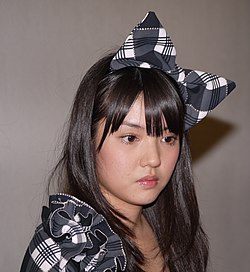Japanese idol
An idol (アイドル, aidoru, from the English word "idol") in the Japanese pop culture is a young media personality (a singer, an actor, a model, etc.). This is usually a teenager, who has a cute and innocent public image.[1] Idols are a separate category of Japanese artists.[2]




The term is commercialized by Japanese talent agents. The talent agencies hold auditions for cute boys and girls and make them stars. Idols are intended to be an ideal object of love of frenzied fans. There is also a view that the Japanese people see idols as sisters or girls next door.[3]
Japanese idol singers work across genres of the Japanese pop music. This is usually whatever is most popular at the moment. Their songs do not require great singing skills, but the artist must be beautiful, sweet and nice to sing them. In their everyday life, idols must also match the songs they sing. They must have a perfect public image and be good examples to young people.
History
changeThe phenomenon appeared in the early 1970s. It was thanks to the popularity of young French actress Sylvie Vartan and the movie she played in called Cherchez l'idole ("Look for the Idol"). The movie came out in Japan in November 1964 under the title Aidoru o Sagase.[4] The term "idol" started being used for girls, mostly between 14 and 16, who were just beginning their path to stardom or for very young new stars.
Selective list of Japanese idol music groups
changeThis is a selective list of Japanese idol music groups, divided by projects or talent agencies.
References
change- ↑ "Pop 'idol' phenomenon fades into dispersion". The Japan Times Online. Archived from the original on 2011-08-13. Retrieved 2014-05-05.
- ↑ Fanning the Flames: Fans and Consumer Culture in Contemporary Japan, ed. William W. Kelly (Albany, NY: State University of New York Press, 2004), p. 65
- ↑ William D. Hoover, Historical Dictionary of Postwar Japan (Lanham, MD: Scarecrow Press, 2011), p. 202
- ↑ "Hiroshi Aoyagi Islands of Eight Million Smiles: Idol performance and symbolic production in Japan. Harvard University Asia Center, 2005. ISBN 978-0-674-01773-3. Introduction, p. 5" (PDF). Harvard University Faculty of Arts and Sciences. Archived (PDF) from the original on 2012-07-06. Retrieved 2014-05-05.
- ↑ "AKB48 │ オリコン芸能人事典-ORICON STYLE" (in Japanese). Oricon. Retrieved 2014-05-05.
- ↑ "ももいろクローバーZ │ オリコン芸能人事典-ORICON STYLE" (in Japanese). Oricon. Retrieved 2014-05-05.
- ↑ "私立恵比寿中学 │ オリコン芸能人事典-ORICON STYLE" (in Japanese). Oricon. Retrieved 2014-04-03.
- ↑ "モーニング娘。 │ オリコン芸能人事典-ORICON STYLE" (in Japanese). Oricon. Retrieved 2014-05-05.
- ↑ "℃-ute │ オリコン芸能人事典-ORICON STYLE" (in Japanese). Oricon. Retrieved 2014-05-05.
- ↑ "Berryz工房 │ オリコン芸能人事典-ORICON STYLE" (in Japanese). Oricon. Retrieved 2014-05-05.
- ↑ "スマイレージ │ オリコン芸能人事典-ORICON STYLE" (in Japanese). Oricon. Retrieved 2014-05-05.
- ↑ "Juice=Juice │ オリコン芸能人事典-ORICON STYLE" (in Japanese). Oricon. Retrieved 2014-05-05.
- ↑ "Buono! │ オリコン芸能人事典-ORICON STYLE" (in Japanese). Oricon. Retrieved 2014-05-05.
- ↑ "Fairies │ オリコン芸能人事典-ORICON STYLE" (in Japanese). Oricon. Retrieved 2014-05-05.
- ↑ "アイドルグループ"9nine"がメジャーデビュー決定! (9nine) ニュース-ORICON STYLE-" (in Japanese). Oricon. 2007-02-15.
- ↑ "武藤彩未が歌う80年代ソロアイドルの名曲が配信へ ニュース-ORICON STYLE-" (in Japanese). Oricon. 2014-05-05.